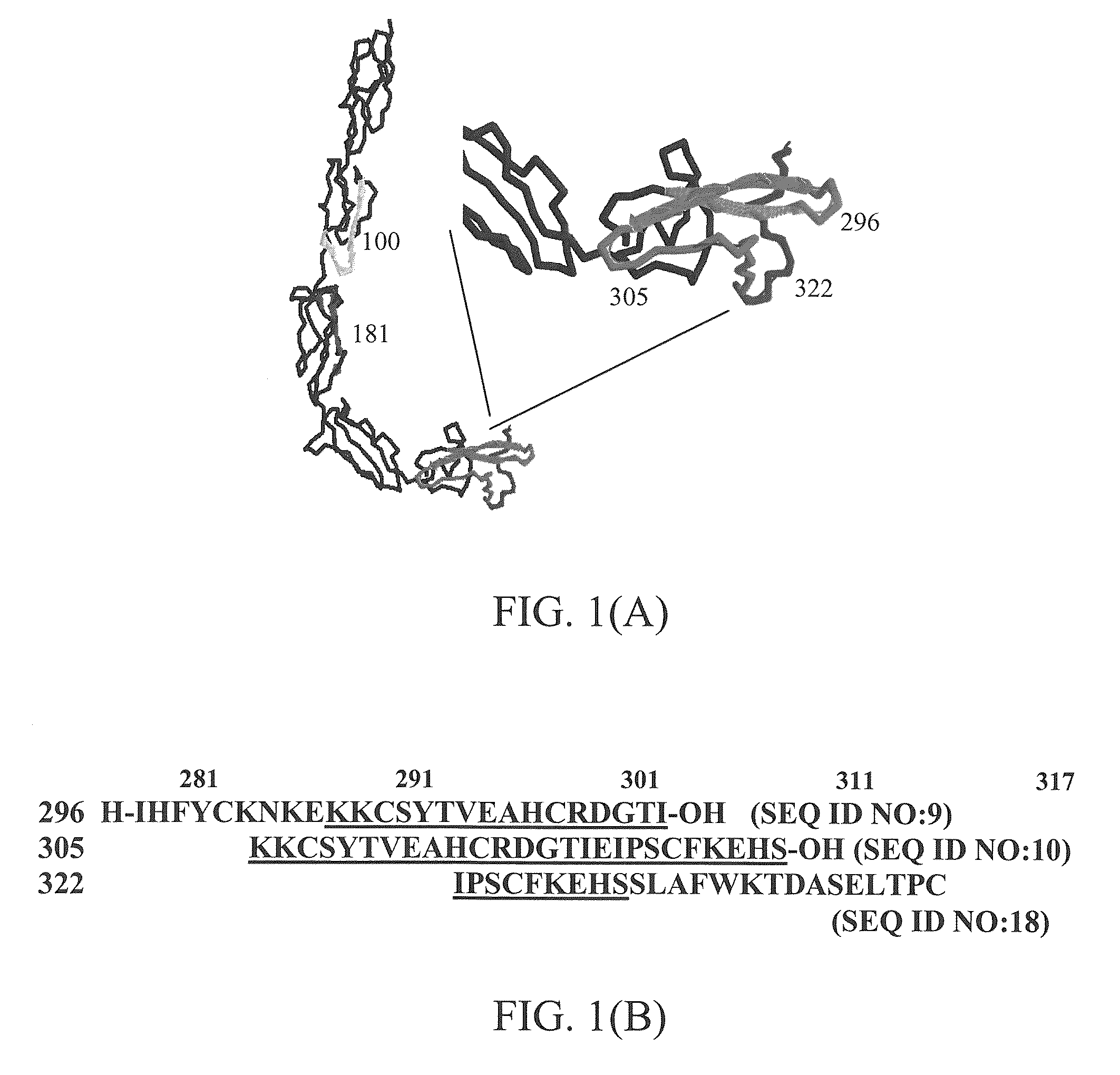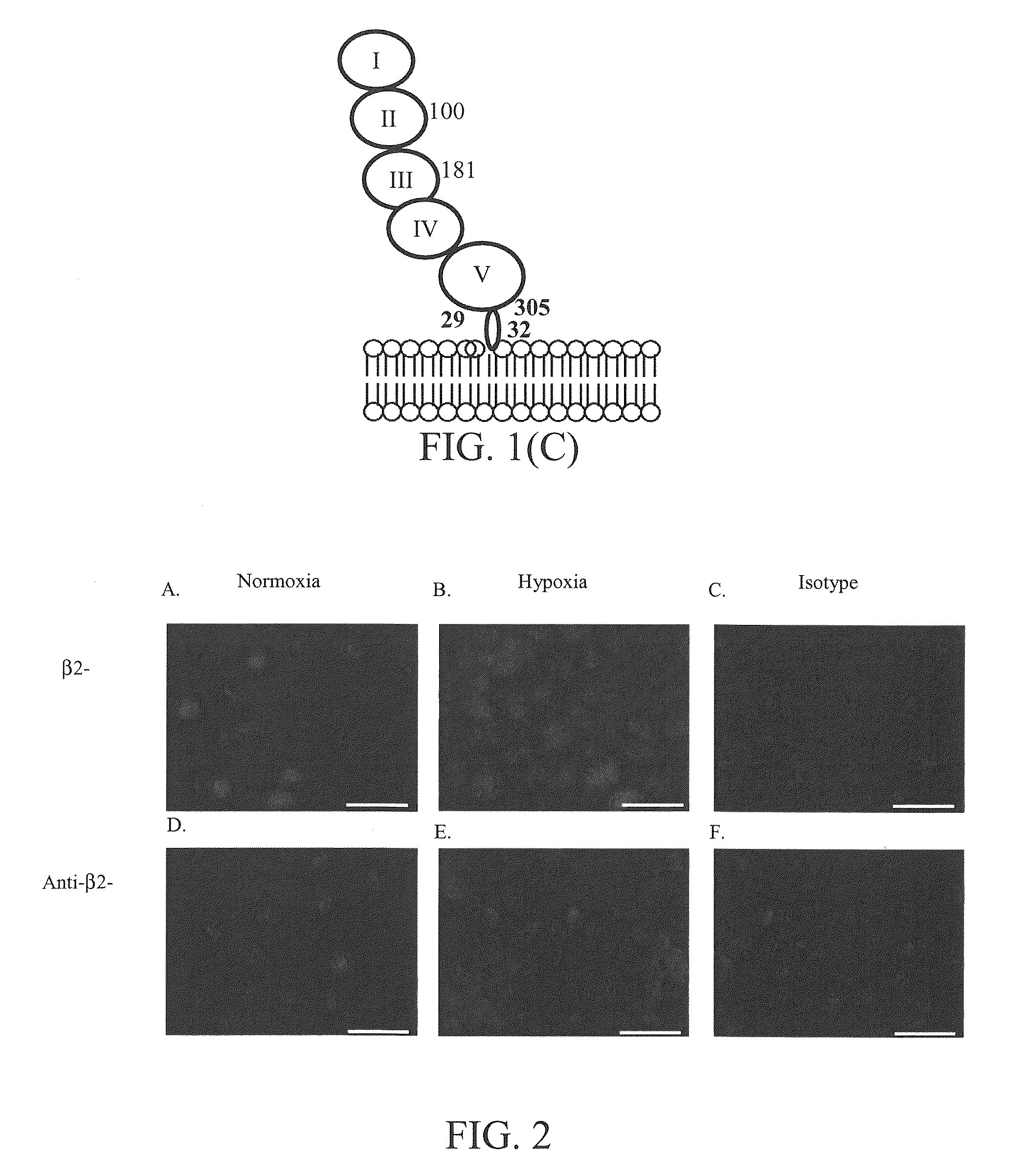β2-glycoprotein I peptide inhibitors
a peptide inhibitor and glycoprotein technology, applied in the direction of peptides, chemical treatment enzyme inactivation, drug compositions, etc., can solve the problems of cellular death and tissue damage, multiple organ failure, and significant increase in tissue damage initiated, so as to prevent or inhibit the growth of cancerous tissue and slow the growth rate of cancerous tissu
- Summary
- Abstract
- Description
- Claims
- Application Information
AI Technical Summary
Benefits of technology
Problems solved by technology
Method used
Image
Examples
example 1
Role of β2-GPI in Ischemia and Reperfusion Injury
[0070]1. β2-GPI Peptides
[0071]The entire mouse β2-GPI sequence (SEQ ID NO. 14) was used to test the effect of β2-GPI on ischemia and reperfusion (“IR”) injury in mice. Sequence fragments and derivatives synthesized based upon mouse β2-GPI were also tested. Various peptides from mouse β2-GPI were designed and then either synthesized in-house or special-ordered from Invitrogen (Carlsbad, Calif.) with purity (>90%) and sequence confirmed by the manufacturer. We hypothesized that if inhibition of antibody binding to β2-GPI on the tissue attenuated injury, then peptides which block the lipid-binding domain of β2-GPI may inhibit β2-GPI binding thereby reducing IR-induced intestinal damage and inflammation as well. Peptides were designed to match sequences from multiple domains of mouse β2-GPI, including domains II, III and lipid-binding domain V, as indicated in the Table below and FIG. 1(A), which shows a ribbon diagram of human β2-GPI wit...
example 2
Administration of Peptides Post-Reperfusion
[0118]Additional work was carried out using procedures outlined in Example 1, however, β2-GPI peptides 296Cys to Ser or 305 peptides were administered to C57Bl / 6 mice subjected to Sham or IR treatment prior to reperfusion, or 15-, 30-, or 60-minutes post-reperfusion. Intestinal injury was scored as described in Example 1 on H&E stained, mid-jejunal tissue sections (75-150 villi per animal). The results are provided in FIG. 13. FIG. 13(A) shows the results of administration of peptide 296Cys-Ser. The results for the administration of peptide 305 are provided in FIG. 13(B). In both graphs, *=p≦0.05 compared to Sham+peptide and Φ=p≦0.05 compared to IR-treated animals not receiving peptides. Each bar is representative of 3-4 animals and each treatment was performed on at least 2 separate days. As can be seen from the data, administration of the peptides after reperfusion was effective for attenuating IR-induced intestinal injury.
example 3
Administration of Human β2-GPI Whole Molecule to Mice
[0119]Additional work was carried out using procedures outlined in Example 1, however, a commercially-available human β2-GPI (SEQ ID NO. 15) was administered to C57Bl / 6 mice subjected to Sham or IR treatment. The mice were administered N. saline or human β2-GPI dissolved in N. saline at 0.5-μg, 1-μg and 5-μg concentrations, and intestinal injury was subsequently scored, as described in Example 1. The results are shown in FIG. 14, where *=p≦0.05 compared to Sham. Each bar is representative of 3-4 animals and each treatment was performed on at least 2 separate days. As can be seen from the data, human β2-GPI effectively competes with mouse β2-GPI and was effective at attenuating IR-induced intestinal injury in the mice.
PUM
| Property | Measurement | Unit |
|---|---|---|
| Body temperature | aaaaa | aaaaa |
| pH | aaaaa | aaaaa |
| pH | aaaaa | aaaaa |
Abstract
Description
Claims
Application Information
 Login to View More
Login to View More - R&D
- Intellectual Property
- Life Sciences
- Materials
- Tech Scout
- Unparalleled Data Quality
- Higher Quality Content
- 60% Fewer Hallucinations
Browse by: Latest US Patents, China's latest patents, Technical Efficacy Thesaurus, Application Domain, Technology Topic, Popular Technical Reports.
© 2025 PatSnap. All rights reserved.Legal|Privacy policy|Modern Slavery Act Transparency Statement|Sitemap|About US| Contact US: help@patsnap.com



